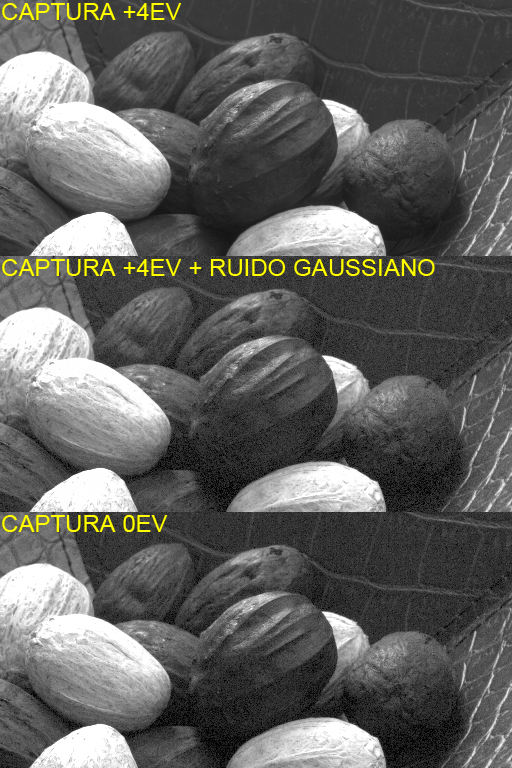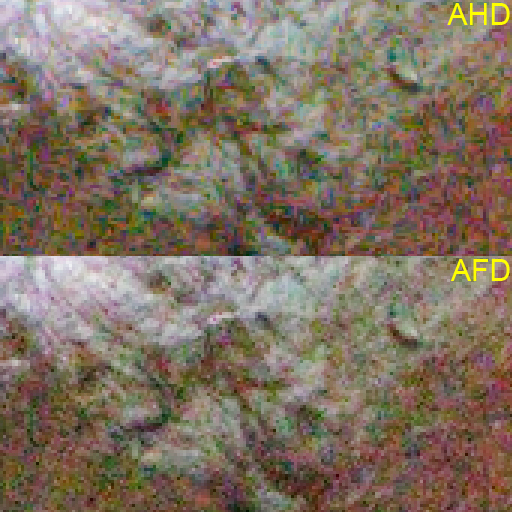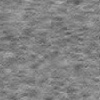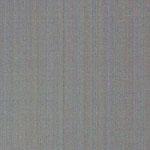Digital grain actually doesn't exist, it's simply the consequence of the way Bayer demosaicing algorithms interpret RAW noise. And RAW noise is just a gaussian noise with zero mean and no spatial structure at all; leaving aside banding noise, the noise present in a pixel of the Bayer array is not correlated in any way to the noise in adjacent pixels. So comparisons done by looking at the result of putting a RAW file into a RAW developer which we even don't know how internally works, have to be taken and interpreted with care (as done here: Which is better: low resolution mode (sRAW) or downsizing afterwards?).
BR
 Helpful Posts: 0
Helpful Posts: 0
Results 1 to 11 of 11
-
5th April 2009, 02:09 AM #1

- Join Date
- May 2008
- Location
- Madrid (Spain)
- Posts
- 169
Does digital image noise have grain like with film?
Last edited by McQ; 5th April 2009 at 03:42 AM. Reason: split thread
-
5th April 2009, 03:28 AM #2Administrator

- Join Date
- Apr 2008
- Location
- California, USA
- Posts
- 1,473
- Real Name
- Sean
Re: Does digital image noise have grain like with film?
I agree that the look of noise can be substantially altered by how the RAW developer software works. However, I would contend that the noise component of one pixel is indeed statistically correlated with noise in an adjacent pixel (and that this is not entirely due to the RAW developer). Otherwise there would be no such thing as how coarse or fine grained the noise appears. Every image would have noise with an apparent size no larger than the pixels -- with no blotches or other patterns. Take the following example:
The above image clearly has a blotchy nature to the noise, and the characteristic size of these blotches is larger than the bayer demosaicing radius. If the noise were purely Gaussian, then it would have a texture similar to this:
The reality is that there are several components to noise, these include random photon noise, read-out noise, etc. What we see as noise in the image is the net result of all of these factors; some have a grain-like nature to them, where the noise texture appears to be larger than the pixel size, and others do not.Last edited by McQ; 5th April 2009 at 03:44 AM. Reason: split thread
-
12th April 2009, 08:46 PM #3

- Join Date
- May 2008
- Location
- Madrid (Spain)
- Posts
- 169
Re: Does digital image noise have grain like with film?
I can't agree with this Sean. First, how do you know which is the radius of the RAW development algorithm? second, how do you know further postprocessing performed by the RAW developer (noise reduction, unsharp mask) has also the same limited radius and didn't spread noise?
To really find out what's going on one must analyse the RAW data, not demosaiced data. I did this and found no spatial correlation between the noise in adjacent pixels. In fact some weeks ago I made the same comparision as you:
- UP: noiseless image
- MID: same image as UP but with gaussian noise added in Photoshop
- DOWN: blue channel in RAW data 4EV less exposed (statistically gaussian, and of course also looking as gaussian)

In the complete article (sorry only online English translation at the moment) also the histograms of the RAW noise can be found.
There can be correlation in noise to adjacent pixels only when talking about fixed pattern noise, i.e. banding noise, but this is not the issue that provides any texture to noise nor creates colour blotches as typically seen on demosaiced data.
The size of the noise also doesn't have to necessarily restrict to the demosaicing technique radius. In AHD for example, several consecutive noisy pixels totally incorrelated, can end in producing maze-like artifacts of several pixels length, because of random concatenation.
AFD on the other side doesn't spread so much as it has much less straight line detection capabilities, so noise is demosaiced in AFD much like individual pixels grain:

BRLast edited by _GUI_; 12th April 2009 at 10:15 PM.
-
12th April 2009, 10:04 PM #4Administrator

- Join Date
- Apr 2008
- Location
- California, USA
- Posts
- 1,473
- Real Name
- Sean
Re: Does digital image noise have grain like with film?
My claim here, and I may be wrong, is that there *is* a texture to digital camera noise, and that it is not purely Gaussian. I would contend that this comes from the analogue to digital conversion within the camera, before anything is written to the RAW data. Although the exact process is proprietary, the A/D conversion varies from manufacturer to manufacturer, and one would therefore conclude that too so can the noise pattern and texture.
The problem with your example is that the demosaiced image makes it more difficult for a viewer to perceive noise texture . . . especially because any A/D filtration is done with full color viewing in mind. Nevertheless, you could run an autocorrelation calculation to numerically demonstrate that each pixel's noise component is not entirely independent of those adjacent to it, and that this number varies from camera model to camera model. That's a lot of work though, so I'm not about to undertake that anytime soon.
Another fair and simpler comparison would be to use two different RAW files from different camera models/brands, but to run them through the *same* RAW converter with identical conversion settings. One would have to use a very basic RAW demosaicing algorithm -- one that does not vary it's algorithm depending on image content, similar to the basic example shown on this site's tutorial on digital camera sensors. If there's any change in the characteristic size of noise between two cameras, then this cannot be entirely due to the RAW conversion algorithm. This would still take a little bit of work.
However, I like to keep things as simple as possible. Without having to do any coding, here's an example that proves that noise in one pixel is not entirely independent of that in another pixel: banding noise.
This is caused by the A/D conversion and read-out process. I don't think anyone can argue that this is entirely due to the RAW conversion. Why else would Canon have required a firmware update to minimize this in their original 1D model, instead of just changing DPP's RAW converter? Does this not prove the claim?
-
12th April 2009, 11:42 PM #5

- Join Date
- May 2008
- Location
- Madrid (Spain)
- Posts
- 169
Re: Does digital image noise have grain like with film?
I agree, and I mentioned banding noise as the only kind of significant correlation that can be found between noise in adjacent pixels. But banding noise is somewhat constant in a row or column (in fact it can be almost eliminated just by substracting two RAW files) and does not produce any spatial structure than can be defined as 'digital grain'.
It's there, and it's visible because we can notice very easily large geometrical patterns, but its contribution to total noise is very low.
I have just done the following: took my dark frame, chose the 800x800 px patch top left, and plotted scatter distributions of R vs G1, R vs B, R vs G2,... all of them yielded the same result which I interpret as the intersection of two uncorrelated gaussian distributions (shown here R vs adjacent G1 pixels):
Tell me if you agree.
BR
-
13th April 2009, 12:28 AM #6Administrator

- Join Date
- Apr 2008
- Location
- California, USA
- Posts
- 1,473
- Real Name
- Sean
Re: Does digital image noise have grain like with film?
Right, banding noise is one example. The point is that the A/D conversion, filtration and read-out can all influence the signal before it is written as a RAW file. Would you claim that no noise or other filtration occurs prior to writing the data into a RAW file? I think it's agreed upon that each manufacturer does *something* at this stage, even if it's proprietary. Anything done here will affect the noise pattern, and will do so in a way that varies from camera model to camera model.
Here's another example though: Noise Reduction Software, such as NeatImage or NoiseNinja. They create a device noise profile not based on the RAW converter, but based on the ISO settings and camera model. Most importantly, these noise profiles are calculated for several spatial frequencies: fine, medium, coarse, etc. Is this just a gimmick? If the shape of image noise were truly just an artifact of the RAW converter, then noise reduction software would be trivial and require minimal profiling.
The problem with this example is that I'm looking at a scatter plot, and I'm supposed to infer that the nature of this scatter closely mimics a Gaussian noise distribution. I don't know about you, but I cannot necessarily tell whether or not something is a perfect Gaussian just by looking at a scatter plot -- especially for two intersecting ones in 2D. After running it through some more processing, it very well may be that your diagram is indeed two Gaussian profiles, but that's not the point. Just because a profile is Gaussian does not mean that there's no apparent texture. The real question is: does the width of this Gassian (or other profile) change depending on ISO, camera model, etc.? Further, your diagram is for just one camera. You would need to do the same test for several substantially different cameras, convert each scatter plot into an autocorrelation curve, and then finally plot all of these on the same graph and show that each curve is identical within a reasonable margin of error. That is quite involved, which is why I did not want to go down that route.Last edited by McQ; 13th April 2009 at 01:18 AM.
-
1st January 2010, 10:53 AM #7
Re: Does digital image noise have grain like with film?
This is mind boggling...

-
12th January 2010, 05:21 AM #8

- Join Date
- Oct 2009
- Location
- USA - California
- Posts
- 445
Re: Does digital image noise have grain like with film?
.... I always enjoy finding people smarter than me

One question though: Can you'all please spell out some of these acronyms? What is AHD and AFD?
I'm trying to follow the conversation and it's hard to tell if the discussion is about what causes the noise - or if the pattern of the noise can be controlled.
From what limited things I know about signal processing, which comes from working with pro audio gear, I would have to agree with McQ that the bulk of the noise is created by the A/D process - once we're in the digital world I would argue that anything past that point is no longer noise, it's distortion -- good or bad - but it's a point of semantics so w/e.
If we're talking more about the pattern/texture of the noise - I have a few thoughts. As we all seem to know in this discussion - noise can take on various patterns. I am surprized that white and pink noise (and their gaussian varieties) havn't come up in this converstation. I do know that the high-end (1/4 mil $) feature high-def cameras do have the ability to control circuitry that changes the grain structure of the video. I imagine that the process however is very different than a still camera -- in video [controlled] grain is desirable, and photography it is not.
I would think that noise is not 'random' on a per-pixel level. Instead, I would propose that there is a falloff curve for any given instance (pop) of noise. The way this ends up being represented on the final raw image would be difficult to see - It makes sence that because the sensor is read in a grid-like fashion noise that might otherwise have a horizontal and vertical falloff might only showup on one axis. It seems hard to conclude that noise has no corrolation with adjacent pixels unless you can gaurentee that the frequency of the noise is perfectly aligned with the frequency of the A/D converter. Since noise varies greatly in bandwidth, it seems very unlikely.
The resulting raw data includes the sum of various noise types, spatial and temporal, it seems to be near impossible to argue completely either way.
So that's my awkward attempt at joining a conversation that is almost completely over my head... Please let me know where I'm thinking stupidly so I can learn
-
13th January 2010, 07:56 AM #9New Member

- Join Date
- Sep 2008
- Posts
- 3
Re: Does digital image noise have grain like with film?
I found something else interesting about this discussion. The question was:
Yet there was no discussion of (film) "grain." What is interesting about--say, black and white--film grain is that we do not see the individual black oxidized silver particles (they are too small). So what do we see? Some sort of (clumping) pattern that our eye/brain makes out of what it cannot see individually? As far as I know it was a puzzle that was never completely solved.Does digital image noise have grain like with film?
On the other hand, NASA probably got the best practical handle on "noise" in trying to sort out data from "static" (e.g., in images) from little 5 watt transmitters 100s of thousands of miles away by using auto-correlators. [Which were later applied, as Mr DUB may know, to analog audio in combination with the fact that correlated information tends to mask "noise."]
Of course, this technique later gave way to a brute force method, namely, keep sending the same data over and over again and since the "noise" is random, the "data" will begin to pile up and overwhelm to static.
I do not know if anyone has tried either technique with digital images, but the latter may be why the 'stacking' of digital images seems, to my eye, to yield a result that reminds me of looking at a bald person's head from a distance.Last edited by Prof. Jewell; 13th January 2010 at 08:01 AM. Reason: Too hard to read
-
13th January 2010, 01:31 PM #10
Re: Does digital image noise have grain like with film?
Regarding comments by KentDub and Blazing Fire, I thought that they might not have seen an image complete with its Bayer array. So here's one:

Most commercial photo-editing software removes the array as a first step, but software developed for astro-photography called IRIS (www.astrosurf.com/buil/us/iris/iris.htm) allows you to load a RAW file and see it in its original state. The image above has been tweaked by me to lighten everything as RAW images are normally very dark, and to enlarge a section to show the array. The image is also in B/W as the colour information is held in separate layers. "Developing" the image (known in IRIS as a CFA image) gives a colour version. However, IRIS is a complex piece of software and a normal photo image is hard to achieve.
Cheers
David
PS Resize the image to see the array.Last edited by David; 13th January 2010 at 01:32 PM. Reason: faulty spacing, image quality
-
15th January 2010, 02:36 AM #11

- Join Date
- Oct 2009
- Location
- USA - California
- Posts
- 445
Re: Does digital image noise have grain like with film?
The array almost looks like halftoning.


 Reply With Quote
Reply With Quote




